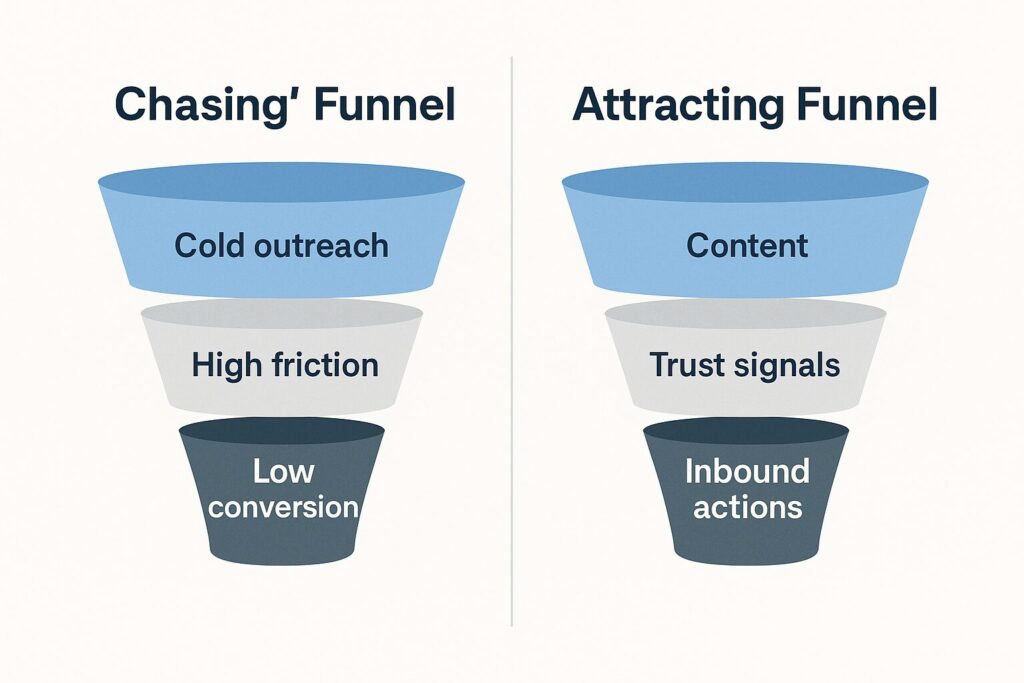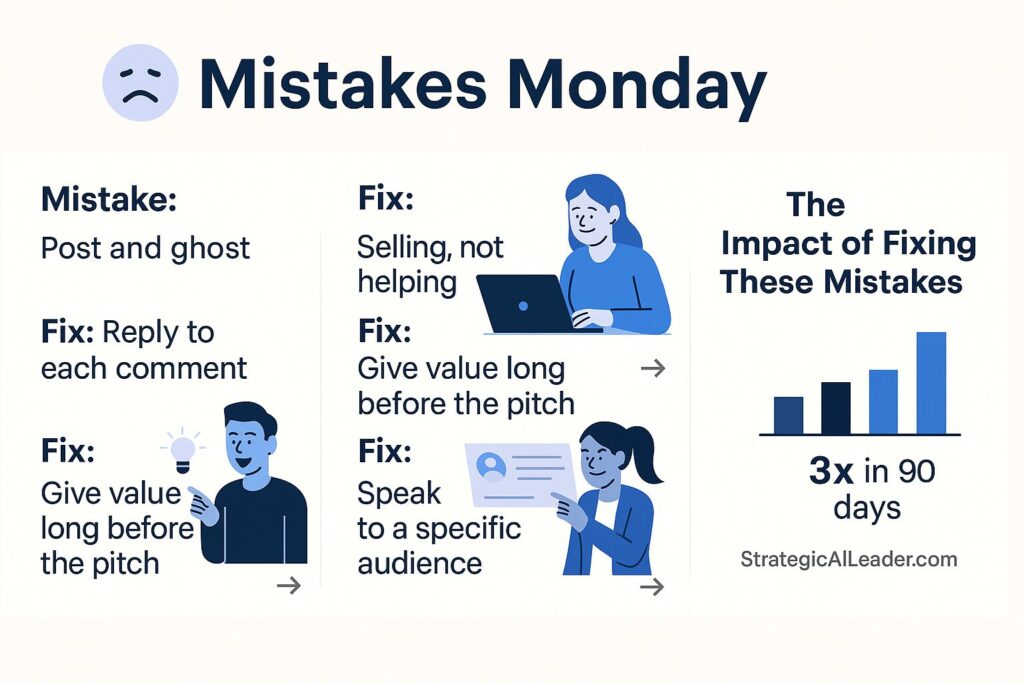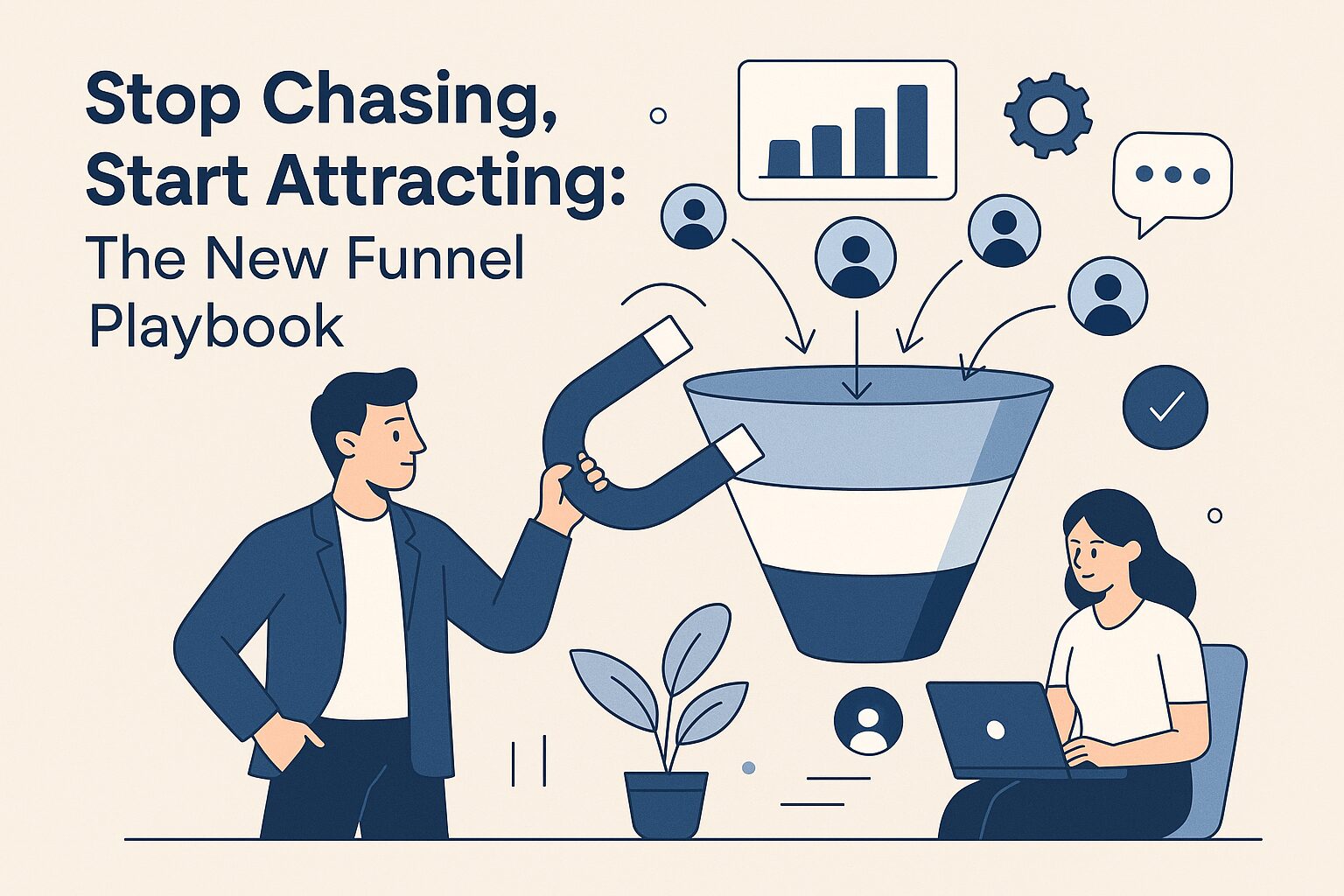Here’s a question that’ll make you squirm: When was the last time you wanted someone to sell you something?
I’m talking about that moment when a salesperson cold-called you during dinner, slid into your DMs with a “quick question,” or ambushed you at a networking event with their elevator pitch. Felt great, right? About as comfortable as a root canal.
Yet here we are, most of us still building our attracting leads strategy like we’re door-to-door encyclopedia salespeople from 1987. We chase prospects like we’re playing tag on a playground, wondering why everyone keeps running away. But what if I told you there’s a better way? Explore what truly moves buyers through your funnel in Skyrocket Growth with Keyword Strategy for Founders.
What if you could stop chasing and start attracting? This is the essence of attraction-based marketing, a strategy that focuses on creating valuable content and experiences that naturally attract leads and customers to your business.

The brutal truth? Your funnel’s not broken – it’s just painfully outdated.
However, the good news is that you don’t have to keep banging your head against the wall with these old tactics. There’s a better way, and it starts with attraction-based marketing.
What Most Leaders Get Dead Wrong About Modern Funnels
Hell, four years ago, I was that guy. You know the one: frantically posting on LinkedIn seven times a day, sending connection requests to anyone with a pulse, and treating my CRM like a slot machine. Just one more cold email, just one more “touching base” message, and surely the leads would start pouring in.
The results? Crickets. Well, crickets and a few angry replies that I won’t repeat here.
The rookie mistake most managers or leaders make is thinking that louder equals better. We confuse activity with strategy, volume with value. We’re so busy chasing that we forget the most powerful principle in business: attraction beats pursuit every single time.
Think about it like dating. The person desperately sliding into everyone’s DMs rarely gets the girl. But the one who’s genuinely interesting, helpful, and magnetic? They don’t chase—they attract.
That mindset shift changed everything for me. Instead of asking “How can I reach more people?” I started asking, “How can I become worth reaching out to?”
The Seven Pillars That Separate Magnetic Funnels From Dead Ones
After studying hundreds of successful inbound funnel strategies and testing everything from AI-powered personalization to old-school content marketing, I’ve distilled what works into seven core principles.
These aren’t theoretical—they’re battle-tested strategies that separate the companies everyone wants to work with from the ones desperately chasing anyone who’ll listen:
1. Authority Through Value-First Content
Stop creating content that screams “buy my stuff.” Start creating content that whispers, “I’m the expert you’ve been looking for.” Your lead generation playbook should begin with establishing genuine expertise.
Research from HubSpot found that companies publishing 16 or more blog posts per month generate almost three and a half times more website traffic compared to companies publishing fewer than four blog posts per month. But here’s the kicker: it’s not about quantity. It’s about becoming the go-to resource in your space.
2. Trigger-Based Automation That Feels Human
Your demand generation framework, which is a strategic approach to creating and nurturing demand for your products or services, needs to respond to behavior, not calendar dates. When someone downloads your guide, visits your pricing page three times, or spends 10 minutes on your case study, that’s a trigger. Automate the follow-up, but make it feel like it’s coming from a human who genuinely cares.
👉 Unlock Better MarTech with AI Marketing Automation – Discover how AI can personalize outreach without sacrificing human connection. Read more →
3. Trust Signals That Matter
Social proof isn’t just testimonials anymore. Modern trust signals include transparent case studies, real customer data, and yes, even your failures. Share the projects that didn’t work and what you learned. Vulnerability builds credibility faster than perfection ever will.
4. Reciprocity Through Genuine Generosity
Give away your best stuff. I know, I know: every consultant tells you this. But most people give away their okay stuff and keep the gold locked away. Flip that script. Your modern marketing funnel should leak value at every stage.
5. Alignment Between Message and Market
Stop trying to be everything to everyone. 77% of B2B buyers say their purchase process was very complex, highlighting the need for tailored, clear messaging and educational content to build trust. And it’s not just B2B. 80% of consumers say personalized experiences make them more likely to buy (Epsilon). Your message needs to hit like a targeted missile, not scatter like buckshot.
6. Community Over Customers
Build a tribe, not a transaction list. The most successful customer acquisition strategies I’ve seen focus on creating communities where prospects become advocates before they ever become customers.
7. Testing Everything, Assuming Nothing
Your funnel optimization techniques should be running constantly. A/B test your email subject lines, sure, but also test your value propositions, your content formats, and even your follow-up timing. What worked last quarter might be killing your conversion rates this quarter.
What worked last quarter might be killing your conversion rates this quarter.
👉 Dive deeper into structured testing systems in The Growth Experimentation Playbook.
Quick Wins You Can Implement This Week
Ready to transform your marketing system design? Here are five changes you can make before your next team meeting:
- Audit Your Last 10 Pieces of Content: Ask yourself, ‘Does this help my prospect become better at their job, or does it just try to sell them something?’ If it’s the latter, rewrite it.
- Create Your “Anti-Pitch” Pitch: Instead of leading with what you do, lead with what your prospects struggle with. “We help overwhelmed marketing directors sleep better at night” hits differently than “We provide marketing automation solutions.”
- Map Your Trigger Moments: Identify the five most essential actions someone can take on your website or in your content. Set up automated (but personal) follow-ups for each one.
- Start Your “Mistakes Monday” Series: Share one lesson you learned the hard way each Monday. Vulnerability builds trust faster than any testimonial.
- Give Away Your Secret Sauce: That methodology you’ve been hoarding? The framework that makes you special? Give it away. Trust me on this one.

According to Forrester’s latest research, B2B buyers are already 80% through their buying journey before contacting a sales rep. Make sure those pieces position you as the obvious choice, not just another option.
Your prospects are already researching solutions to their problems. The question is: Will they find generic sales content, or will they discover a valuable resource that happens to be created by the person who can solve their problem?
The Uncomfortable Truth About Modern Marketing
Here’s where I’m going to challenge some conventional wisdom: The best full funnel marketing strategies feel Nothing like marketing at all.
They feel like education. Like mentorship. Like that colleague who always has the perfect article to share or the exact framework you need.
Most marketing feels transactional. Modern attraction feels transformational.
If you’re serious about attracting, not chasing, leads, your content calendar shouldn’t look like a product brochure. It should function like a curriculum that measurably improves your prospect’s job performance.
It means your email sequences shouldn’t just nurture leads, they should nurture better professionals.
In a high-trust funnel, sales conversations should not start with cold discovery calls. They should begin by reaching out to buyers who already know, like, and trust them, saying, “I’m ready to work together.”
That’s not just a better customer experience. Companies with excellent customer experience outperform their industry peers, driving revenues 4–8% higher than the market average. It’s also better business.
Your New Funnel Reality Check
The transformation from chasing to attracting isn’t just a tactical shift. It’s a complete paradigm change. You’re no longer in the business of interrupting people with your message. You’re in a position to become so valuable that people seek out your message.
This approach requires patience, consistency, and yes—a little faith. You’re playing a longer game, but it’s a game with exponentially better rewards.
👉 Balance long-term strategy with the right mindset using Build a Powerful Personal Operating System and Take Control (CLEAR Framework)
The companies crushing it with attracting leads understand something their competitors don’t: In a world where everyone is shouting, the person worth listening to whispers.
Your prospects don’t need another sales pitch. They need a guide. They don’t need another vendor. They need a trusted advisor.
The question isn’t whether this approach works; the question is whether it works. I’ve seen too many success stories to doubt that. The question is whether you’re ready to stop chasing and start attracting.
Ready to build a funnel that works while you sleep and attracts your ideal customers like a magnet? The playbook is right here. The only question left is: What are you waiting for?
If you’re serious about turning ideas into insight – and insight into growth, don’t miss my Notion Experiment & Hypothesis Dashboard. It’s the exact system I use to track high-impact tests, prioritize ideas, and learn faster than the competition.
✅ ICE & RICE scoring
✅ Learning Velocity tracking
✅ Built-in Experiment Library
✅ Custom views for weekly reviews and reporting
👉 Check out the dashboard now and start running experiments with clarity, consistency, and confidence.
Related Articles
Unlock Massive Growth with This 4-Step SEO Funnel
Proven B2B Outreach Strategy That Gets Real Results
The Best B2B vs B2C Testing Strategies for 2025
B2B & B2C Metrics Series
How to Create a Winning Data-Driven Sales Strategy
B2B Metric Frameworks Infographics: Unlock Growth & Profits Now
About the Author
I write about:
- AI + MarTech Automation
- AI Strategy
- COO Ops & Systems
- Growth Strategy (B2B & B2C)
- Infographic
- Leadership & Team Building
- Personal Journey
- Revenue Operations (RevOps)
- Sales Strategy
- SEO & Digital Marketing
- Strategic Thinking
📩 Want 1:1 strategic support?
🔗 Connect with me on LinkedIn | (Follow Me)
📬 Read my playbooks on Substack

Leave a Reply